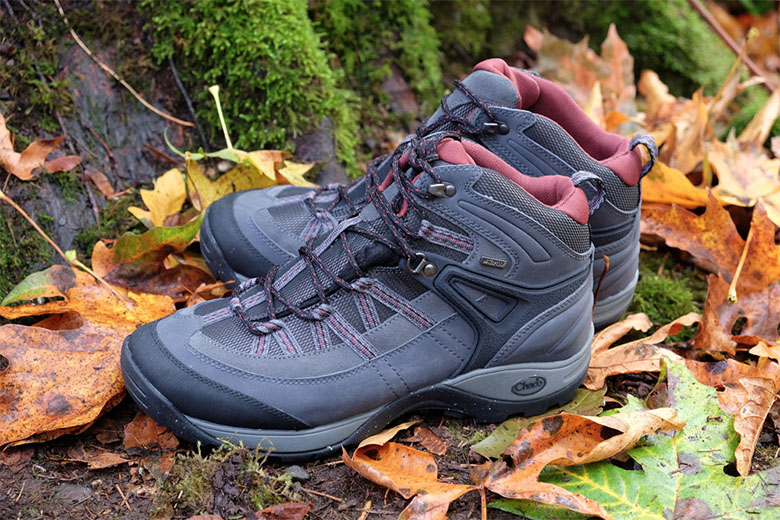



The Holbuck men’s hiking boot represents the company’s further foray into serious hiking footwear. The boot has a water resistant leather and suede upper along with a waterproof bootie. It also features Chaco’s popular Luvseat footbed, which can be found on many of the their sandals and water shoes. After taking the Holbuck out for a spin in the Cascades, I was impressed: it has the feel and comfort of a lighter weight trail shoe with the support of a hiking boot. For shoulder season and wet weather hiking, this boot is a winner.
Weight: 17 oz. (single)
Waterproof: Yes
What we like: Comfortable and light for a hiking boot.
What we don’t: Warmth retention isn’t ideal for hot summer days.
Best uses: Fall and spring hiking, winter snowshoeing.
Price: $150 from Amazon
In terms of fit, the Chaco Holbuck runs a bit larger than most other hiking footwear that I have worn in the past. I ordered a 12—my usual size in hiking shoes and boots from brands like La Sportiva and Salomon—and could have gone with an 11.5, depending on intended use and sock choice. If you’re on the border between two sizes, I would lean toward the smaller size.
In terms of comfort, the Holbuck feel considerably lighter on the foot than a traditional hiking boot (this is a good thing). They weigh 34 ounces for the pair, making them among the lightest hiking boots on the market. The next thing I noticed, particularly when I got moving on the trail, is the feel on the bottom of the feet. The Luvseat footbed is comfortable and fits well right out of the box. This doesn’t come as a surprise—if there is anything you would expect to be best in class from Chaco, it’s the footbed.
Where the Holbuck acts more like a boot and less like a shoe is the high ankle. The vertical rise from the bottom of the shoe to its high point on the heel is 7 inches, a full 2 inches higher than my La Sportiva hiking shoes. This design is ideal if you value ankle support and toughness, but also makes them a bit slower on the trail than a lower-cut hiking shoe designed for speed.
We took the Chaco Holbuck out on a fall day hike in the Cascades and haven’t yet had the opportunity to test it on a backpacking trip with a heavy pack. However, on our day hike with a day pack the Holbuck was impressive in both its performance and comfort. The footbed provided ample cushion on tough terrain and the sole was grippy even on wet rocks and roots. I tested the waterproofness of the boot on a small stream off the trail and in mud and puddles along the way, and the waterproof booties performed as advertised.

One consideration is that when you’re really working on the trail, the Holbuck retains a decent amount of warmth inside the boot. On my hike it was 59 degrees and I was wearing Smartwool’s Medium Crew sock, and although my feet didn’t overheat, a lighter weight sock would have been preferable. Warmth is to be expected with a waterproof bootie—no matter the breathability ratings of any waterproof footwear, the materials ventilate less than their non-waterproof counterparts. Given that some of the best uses for the Holbuck are fall, spring, and other cool weather hiking, this may be an issue for many situations (or even a positive). But if you’re hiking in the summer or your feet tend to run hot, you’ll definitely want to use a lightweight hiking sock (you also should take your primary sock choice into consideration when choosing boot size).
I would highly recommend the Chaco Holbuck to those who want ankle support without the bulky and weighty feeling of a traditional hiking boot. The overall level of comfort, and particularly the footbed, was impressive and the boot took on obstacles and moisture very well on the trail. At 34 ounces for the pair, they are lightweight but still offer solid ankle support and waterproofing.
In terms of specific uses, the Holbuck is best suited for fall, spring, and alpine hiking when the conditions are cool and wet. The waterproof bootie is a great feature, but it does add some warmth and your feet may get toasty in the heat of the summer.
I definitely will keep this boot in my quiver for shoulder season hiking and forays into the backcountry where moisture may be an issue. Given the warmth retention and waterproofing, I also think it will make a good snowshoeing boot in the winter.